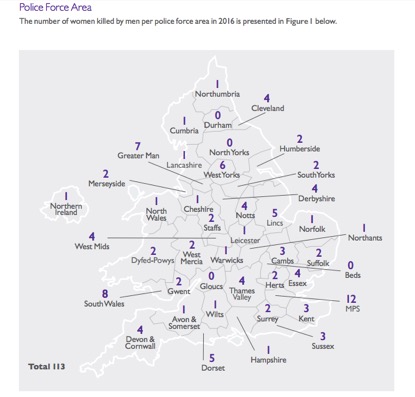Commercial Insights

In light of the recent conviction of a man guilty of killing multiple female partners, we look at the statistics around femicide: who is most likely to commit this crime, where, and to whom, as well as the potential steps that could be taken to curb the frequency of its occurrence.
Earlier this year, a man was sentenced to life with a minimum of 26 years for killing his former partner. Shockingly, this was not the first time he’d killed a woman close to him: Theodore Johnson had committed similar crimes twice before, and both times was set free to commit it again.
Johnson first killed a woman in 1981, when he tipped his wife over the balcony of their ninth-floor flat in Blakenhall Gardens, Wolverhampton, having already hit her with a vase. They had been arguing, which enabled him to plead guilty to manslaughter on the grounds of provocation. He was jailed for just three years – the same sentence many people are given for graffiti crimes.
The second woman Johnson killed was in 1992. He strangled another partner with a belt while their baby slept, after she refused the box of chocolates he had bought to win her back. He pled diminished responsibility and, after a two-year stay in a secure psychiatric unit, was released and was yet again free to form new relationships.
Then, in December 2016, Angela Best became the third victim of Johnson – now aged 64 – when he beat her with a claw hammer and throttled her with a dressing gown cord after she met another man.
Sadly, he is not the only male perpetrator of femicide to have been given the opportunity to reoffend. In July last year, Robert Trigg, 52, was convicted of the murder of his partner Susan Nicholson six years earlier, and the manslaughter of his previous girlfriend, Caroline Devlin, five years before that. The deaths had initially been treated by West Sussex police as unsuspicious – the murder and manslaughter convictions were obtained only after the family of Nicholson, unconvinced by the police investigation, commissioned an independent pathologist to investigate.
There are many other cases of women being killed by current or previous partners, many with histories that could serve as a warning about their potential violent tendencies. To shed light on the phenomenon of domestic homicide, Women’s Aid, in conjunction with Karen Ingala Smith (who set up the blog Counting Dead Women), has for the past two years published what it calls a “femicide census”. It records all the women killed by men in a year and recently published data for 2016 showing that 113 women were killed by men in England, Wales and Northern Ireland.
Now, victim support groups are calling on MPs to back a new law allowing police to take proactive measures to establish whether a serious offender has a new partner, and if so to inform them of his previous convictions.
Under “Clare’s law”, the domestic violence disclosure scheme introduced in 2014, police can inform a woman of a new partner’s past, but this depends on a woman making an inquiry.
Under the new law that Plaid Cymru MP Liz Saville Roberts hopes to introduce – via an amendment to the government’s domestic violence bill – police would be duty bound to create a database holding the convictions and cautions of anyone found guilty of offences including manslaughter, murder, rape or repeated instances of domestic violence or coercive control.
Officers could make unannounced visits to offenders, who would face prison if they failed to inform the authorities they were in a new relationship. Police would then have the right to inform the woman of a new partner’s convictions.
Campaigning charity Voice 4 Victims is also calling for this change. Voice 4 Victims' Harry Thatcher said in a recent statement: “There has to be a mechanism whereby the potential new partner of somebody who's killed before knows about the convictions and then she can make an informed decision about whether she continues the relationship or not.
“We can't rely on him telling her because clearly he won't do that because the relationship wouldn't have got off the ground in the first place.”

Source: The Femicide Census, Womens Aid
Femicide Census
What is the Femicide Census?
The Femicide Census is a database containing information on over one thousand women killed by men in England and Wales since 2009. It is a ground-breaking project which aims to provide a clearer picture of men’s fatal violence against women by allowing for detailed tracking and analysis.
It was developed by Karen Ingala Smith and Women’s Aid working in partnership, with support from Freshfields Bruckhaus Deringer LLP and Deloitte LLP.
The census was developed out of an “urgent need to address the reality of fatal male violence against women”. It can play a key part in the identification of patterns of femicide, the circumstances leading up to it and ultimately help to reduce femicide.
In February 2015 the Femicide Census was launched. It was based on information collected by Karen Ingala Smith and recorded in her blog Counting Dead Women. Since January 2012 she has searched the web for news of women killed by men; information that was hidden in plain sight- in a plethora of Domestic Homicide Reviews, police statistics, local press articles and reports in which women killed by men were mentioned.
She gathered details of the perpetrators and the incident of murder itself, including the date, names, police force area and information about children, recorded motive and the weapon. In December 2016, the first Femicide Census Report was released.
What are its latest findings?
The Femicide Census published in 2017 found that between 1 January 2016 and 31 December 2016:
Victims:
• 69% of women were killed by a current or former intimate partner.
• 7.1% of women were killed by a male family member, i.e. a son, father, brother, nephew or grandson.
• 12.4% of women were killed by a man they knew, but who was of no intimate or familial relation to them.
• 7.9% of women were killed by a stranger.
• The greatest number of femicides occurred within the London Metropolitan, South Wales and Greater Manchester police force areas.
• 75.2% of women were killed at their own home, or the home they shared with the perpetrator.
• 77.4% of women killed by their ex-partner or ex-spouse were killed within the first year that followed that separation.
Perpetrators:
• 27.5% of perpetrators were aged between 36 and 45.
• In 47 cases, perpetrators used a sharp instrument to kill their victims.
• 19 men suspected of killing a woman either killed themselves or died prior to trial.
• 37 perpetrators pleaded not guilty to murder, 28 of whom were found guilty of murder.
• 84 perpetrators were found guilty of murder, manslaughter or of causing death Nine in 10 women killed during 2016 died at the hands of someone they knew.
Of these, 78 women were killed by their current or former intimate partner, three by their sons and five by another male family member. Just nine were killed by a stranger. Women’s Aid said that the census revealed patterns in the killings. Many were committed in similar locations, a sharp instrument was used as a weapon in 47 cases.
Source: The Femicide Census Report for 2016, Womens Aid
Academy tools to help you get a job
-

Free Watson Glaser Practice Test
Understand the test format, compare your performance with others, and boost your critical thinking skills.

